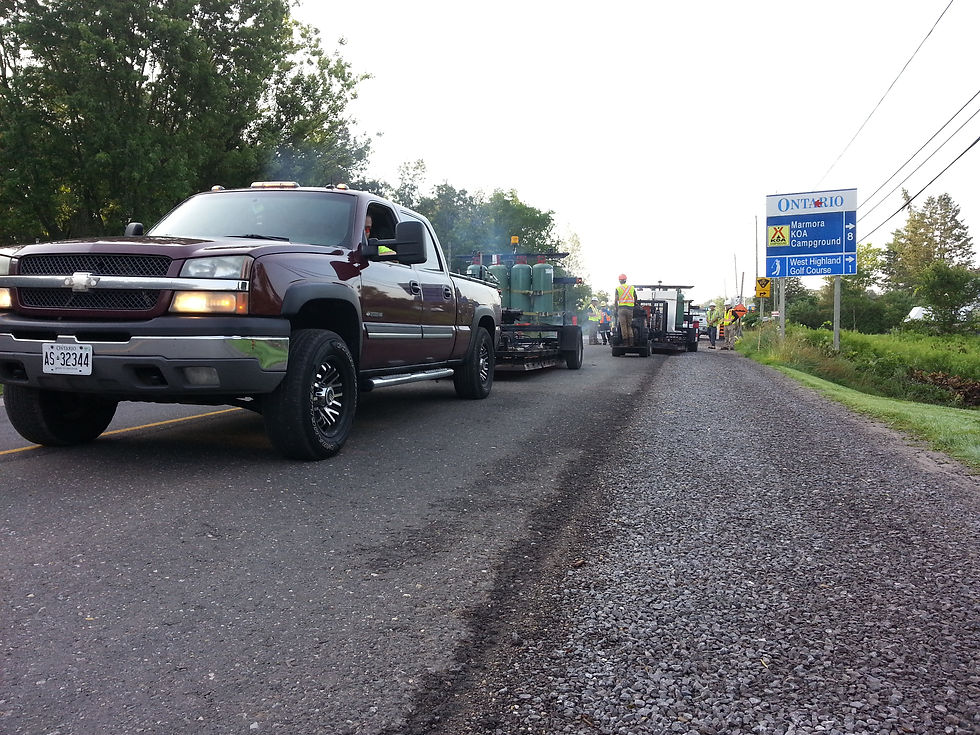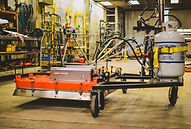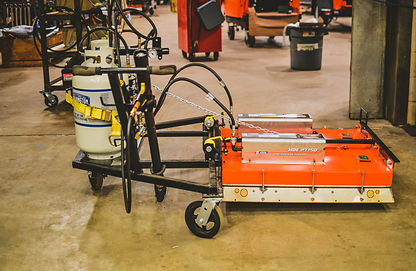
APPLICATIONS
INFRARED TECHNOLOGY
The Infrared process works by using propane mixed with air to increase heat. In turn, this extreme heat is absorbed by a patented ceramic blanket that, when heated, emits approximately 18,500 BTU's per square foot. In less then ten minutes the blanket will heat the asphalt to 350 degrees 2.5" deep or the carfare course in an area as large as 102 square feet per ten minute heat. The infrared heat will not burn the asphalt. Therefore, the result is asphalt equivalent to fresh plant mix. In most cases, fresh mix is added from a heated hot box to bring the grade of the patch to the proper height. The patch is then compacted to form a seamless patch.
EFFECTIVE IN THE REPAIR OF:
-
Potholes
-
Raising manhole utility covers
-
Failed pavement joints
-
Joint repair: concrete and asphalt
-
Asphalt removal from wood and concrete
BENEFITS:
-
Regrading onto existing pavement
-
Oil spots in parking areas
- Repairing approachables
- Dips in the road/parking lot
- Leveling frost heaves and trip hazards
Not only does infrared repair create a higher quality, long-lasting repair by establishing a thermal bond with the surrounding pavement pavement, preventing seams for water to re-enter and cause joint failure, but it also comes with numerous b\other benefits to you, your client, and the planet.
SAVE TIME
Repairs can be made at a fraction of the time of conventional methods, and your road, parking lot, or driveway can be open to traffic immediately after.
SAVE MONEY
Savings realized in materials, manpower and machinery make infrared the only choice if you are looking for greater value over more traditional methods.
SAVE RESOURCES
Recycling existing asphalt reduces waste by 80%, and less machinery is required to get the job done! That's something we can all feel good about!
COLD WEATHER PAVING
In northern climates, paving becomes a problem in colder months when ambient temperatures do not meet the specifications set by governing agencies. A typical specification is that paving can only be done when ambient temperatures are a minimum of 10ºC (50ºF) and rising, or base mat temperatures are 2-3ºC (35-37ºF) and rising. Either contractors lose money waiting for the sun to shine enough to meet these specifications, or agencies relent and allow paving because "it has to be done". This will lead to future pavement problems as the cold base asphalt steals the heat from the new hot mix before the new lift can be compacted, preventing the formation of a good bone. If a tac coat is applied in very cold weather it will not work to provide the bond, and, in fact, it may provide a mechanism for de-bonding, and so it is often skipped.
Lack of compaction in asphalt pavement has been shown to affect life cycles by 30-40%. See infrared camera documentation of bade pavement temperatures after heating to ensure good base asphalt temperatures.
Paving in cold weather can cause raveling, slippage, increased moisture retention, increased cracking, and delimitation and slippage with the base.
HDE infrared heaters have been used on major highways in Ontario since 1996, extending the paving season and ensuring a better quality construction. In Oklahoma a customer attaches a 16'x6' HDE infrared heating deck directly to the paver, behind the matter transfer vehicle, heating the base asphalt to 90ºF at paving speeds. This allows paving for full days in winter months when they may otherwise have to sit for two to three hours waiting for good ambient temperatures.
In 1997 HDE heaters were used by a major paving contractor in Ontario to pave over a milled surface on the 401 and 402 (main transportation routes through the province), allowing 60,000 tons of hot mix asphalt to be placed in late November and early December when they were faced with allowing the milled surface to be left until the spring, causing significant safety problems. The new course bonded well, with no problems, and lasted many years. In northern Ontario when a bridge fail occurred on the Trans Canada highway in mid-January it was necessary to build a detour in the coldest month of the year.Concerns of delimitation of the final surface were alleviated when HDE infrared heaters were used to pre-heat the base asphalt in temperatures of -8ºC (17-18ºF). The detour lasted until spring break-up when the bridge was put back in service. No problems were encountered when the surface course on the detour, even with the high traffic of transports driving.
The infrared heater decks can also be purchased to dry concrete bridge decks in the late fall weather and to allow the safe application of waterproofing membranes and subsequent pavement structure.




JOINT MATCH HEATING
HISTORY OF JOINT HEATING
Construction of longitudinal joints is recognized as one of the most significant asphalt paving construction problems today. At the Swift Airport Conference in Calgary a presentation on longitudinal joints was given by Mr. Rob McClure P. Eng of Hatch, Mott, MacDonald. The presentation outlined the problems of constructing a good longitudinal joint using a case study of a paving project done in 2007 at the DFC Shearwater Heliport in Dartmouth, N.S., Canada. The specifications required cutting and removal of the edge of the cold lane prior to tacking and butting up the new pavement lane. The paving contractor requested and received approval for using an alternate method using a HDE longitudinal joint heater.
The joint heating proved very effective, saving the contractor money in material, labour, and project time. All the test results using the joint heater met the required compaction, whereas the specified technique of cut joints had failures. The appearance of the joint was excellent. The cost was reported to be in the area of $0.15 per lineal meter ($ 0.05 cents per foot), which is considerably under any other longitudinal joint construction technique cost, even considerably under any joint repair technique. The 2008 project specifications were changed to include joint heating.
JOINT REPAIR
The HDE JMH can also be used for longitudinal joint repair to ensure a better watertight joint and prevent accelerated deterioration. It is particularly cost effective when the joint has widened to such an extent,that joint filler will not stay, or when the cracks have spread to the adjacent joint. By re-heating the asphalt it can be reworked, asphalt can then be added to fill in any voids in the pavement. This process creates a lasting seamless repair
Heat Design Equipment Inc. has been promoting the idea of a re-heated joint since 1995, and have been supplying equipment to meet a hot joint specifications in the Province of Quebec since it was enacted in 1995. HDE’s joint heaters have been used on numerous projects since then, both in Canada and the United States. The Shearwater project could be considered the best documented project. Using the joint heater allows the contractor to heat the cold, un-compacted edge to temperatures of +100C (212F) at regular paving speeds in conventional paving temperatures. For faster speeds and colder weather, additional heaters can easily be added so the contractor has the opportunity to re-compact the edge, making a seamless, watertight joint.
A comparable project in Toronto, Ontario, Canada, involved heating 2200 feet (700 meters) of unacceptable joint paved the previous fall. Salt and sand had penetrated the joint and the authority required complete removal of the joint 4” (100mm) on either side of the joint or the contract alternative to the repair which was grinding and removal of the entire lane. Removal of the joint was easily done after heating, new asphalt was then placed and compacted. The authority required an extension of the warranty on the joint for one year, and prior to expiry requested further repair on just 20 ft (6 meters). At that point it was difficult to identify where the joint was.
A 2005 joint repair of 1000 feet of raveled joint at The White House on Pennsylvania Avenue confirmed that joints can be reheated efficiently and structurally repaired with no physical damage to the properties of the asphalt. The unique synthetic asphalt with a clear resin and two colored aggregate exhibited properties similar to polymer modified asphalt, with a lower softening point. Making a good longitudinal joint without echelon paving proved challenging to the contractor. Two 500 foot joints were not acceptable. Joints were repaired by the contractor using the HDE JMH 400T to reheat the joint and an HDE mini recycler was used to reheat material required to fill the gap in the joint. The work was done to the satisfaction of the Federal Highways and after three years the repairs remain in good condition. In 2008 HDE was invited back to repair additional areas that had failed due to cracking of the joint.
One of our previous projects for the Ministry of Transport of Ontario was in 1997 on the Queen Elizabeth Way, where after 11 years “ the longitudinal joints continue to perform well.”
While the idea of a hot joint is not new, echelon paving is recognized as the best way to achieve a good longitudinal joint. However, at HDE we believe that joint heating is the next best thing, providing it can be done efficiently, without overheating the asphalt. Our clients have been successfully using our joint heaters in Quebec, Ontario, Nova Scotia , Newfoundland, Tennessee, Mississippi, Delaware, Michigan and Washington DC (The White House) on actual projects.




CRACK REPAIR
HDE has some of the largest and longest machines on the market. This allows our customers to make cost effective repairs to long, narrow cracks or utility trenches. Using conventional IR process, the HDE equipment can either use single machines, or multiple machines in a row to make repair work faster.




THERMOPLASTIC INSTALLATIONS
HDE uses our infrared heaters to install many thermoplastic pavement marking such as:
-
Inlaid Thermoplastic
-
Surface Applied Thermoplastic
-
Pavement Markings
Preformed thermoplastic is a durable pavement marking system where thermoplastic symbols and legends are supplied in their final form and shape.
Preformed thermoplastic pavement marking material combines the convenience of preformed markings with the performance qualities of hot applied thermoplastic.














